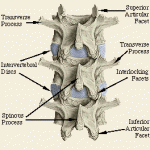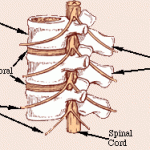 Your spine is made up of 24 small bones (vertebrae) that are stacked on top of each other to create the spinal column. Between each vertebra is a soft, gel-like cushion called a disc that helps absorb pressure and keeps the bones from rubbing against each other. Each vertebra is held to the others by groups of ligaments. Ligaments connect bones to bones; tendons connect muscles to bones. There are also tendons that fasten muscles to the vertebrae. The spinal column also has real joints (just like the knee or elbow or any other joints) called facet joints. The facet joints link the vertebrae together and give them the flexibility to move against each other.
Your spine is made up of 24 small bones (vertebrae) that are stacked on top of each other to create the spinal column. Between each vertebra is a soft, gel-like cushion called a disc that helps absorb pressure and keeps the bones from rubbing against each other. Each vertebra is held to the others by groups of ligaments. Ligaments connect bones to bones; tendons connect muscles to bones. There are also tendons that fasten muscles to the vertebrae. The spinal column also has real joints (just like the knee or elbow or any other joints) called facet joints. The facet joints link the vertebrae together and give them the flexibility to move against each other.
Each disc is made up of two parts. The hard, tough outer layer, called the annulus, surrounds a mushy, moist center, called the nucleus. When a disc herniates or ruptures, the soft nucleus spurts out through a tear in the annulus and can compress a nerve root. The nucleus can squirt out on either side of the disc, or in some cases, both sides. The amount of pain associated with a disc rupture often depends upon the amount of nucleus that breaks through the annulus and whether it compresses a nerve.
 Degenerative disc disease (DDD) is typically associated with aging. As you age, your discs, like other joints in the body, can degenerate (break down) and become problematic: That’s a natural part of growing older as your body deals with years of strain, overuse, and maybe even misuse. However, DDD can occur in people as young as 20, so sadly, youth doesn’t always protect you from this disc-related spinal condition.
Degenerative disc disease (DDD) is typically associated with aging. As you age, your discs, like other joints in the body, can degenerate (break down) and become problematic: That’s a natural part of growing older as your body deals with years of strain, overuse, and maybe even misuse. However, DDD can occur in people as young as 20, so sadly, youth doesn’t always protect you from this disc-related spinal condition.
There is also an interesting data about the disks. As you age, the discs can lose flexibility, elasticity, and shock absorbing characteristics. They also become thinner as they dehydrate. When all that happens, the discs change from a supple state that allows fluid movement to a stiff and rigid state that restricts your movement and causes pain.
To help alleviate the pain, the DRX System can be used. The System works by gently separating the vertebrae above and below the involved disc. This separation causes a negative pressure to be exerted on the disc creating a vacuum effect. The negative pressure draws the bulge or herniation back within the disc space similar to an eyedropper drawing in fluid. In the case of degenerative disc disease, the negative pressure draws fluids, nutrients and oxygen from the surrounding tissues, resulting in disc rehydration and repair.